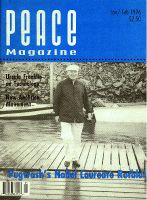
Peace Magazine Jan-Feb 1996, page 4. Some rights reserved.
Search for other articles by PMag staff here
January is a time for stock-taking. How is the peace movement doing? Up and down. There situation in the Middle East is encouraging. In Bosnia-Herzegovina, the NATO troops are settling in forat least a year of peacekeeping, as the Dayton agreement begins to take hold. Yet Chechnya is still a war zone and old wars continue on every continent. So we are not making much progress.
What about the success of our strategies? The longest-term contradiction within the peace movement is that between a commitment to nonviolence on the one hand and a reliance on "collective security" on the other. There seems little evidence that people are adopting nonviolent strategies instead of military ones. In former Yugoslavia, nonviolence is not even being considered - nor has it been considered seriously for a long time. What we have, at best, is an enforced period of quiet, which has resolved none of the disputes. Is that the best "peace" we can hope for?
Nationalism remains the greatest danger to peace. In 1994, there were 39 wars - half of them wars of secession. What can we do about this? Let's begin at home, for we cannot ignore the possibility of violence in the unending dispute between some Francophones and the federal government, as well as some Native people. Any solution will require re-thinking Canada's constitution - like it or not. So let's do it.
More generally, let's focus on war-prevention. This will include setting up an early warning system to enable us to see ahead and intervene in warlike situations before violence takes over. Ursula Franklin says Nigeria is probably the place to watch most closely today.
If nonviolence is to work, some of us must go and build peace up where and when it is in jeopardy.

Peace Magazine Jan-Feb 1996, page 4. Some rights reserved.
Search for other articles by PMag staff here